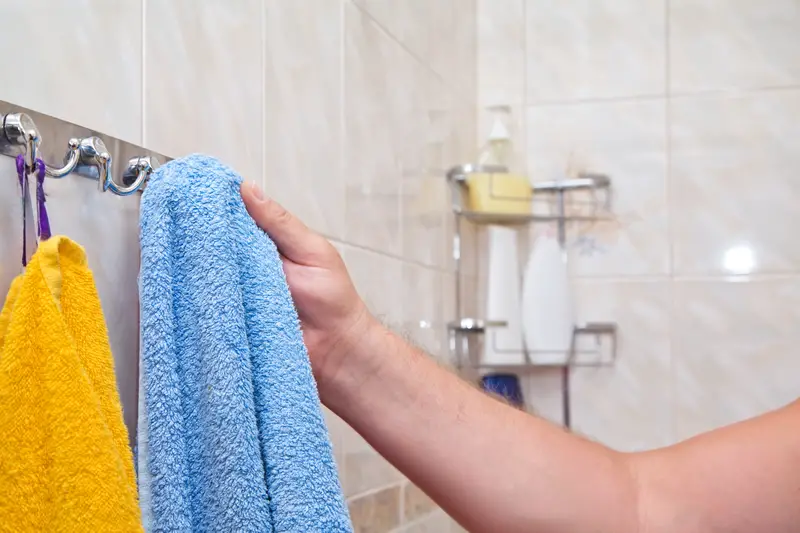Picture walking into your bathroom and finding a soggy towel crumpled on the floor, smelling musty and taking forever to dry. Most people think hanging a towel is straightforward, but the wrong approach creates problems that range from mildew growth to damaged walls. These common towel-hanging mistakes turn your bathroom into a breeding ground for bacteria while wasting money on towels that wear out too quickly.
Folding towels over bars creates damp disasters
Many homeowners automatically fold their wet towels into neat thirds before draping them over a towel bar. This creates multiple layers of damp fabric that trap moisture between the folds. The inner sections stay wet for hours longer than necessary, creating perfect conditions for mildew and unpleasant odors. The lack of air circulation means these folded sections never fully dry, leaving towels feeling clammy and developing that distinctive musty smell.
Instead of folding, spread the entire towel across the full length of the towel bar. This allows air to circulate around both sides of the fabric, cutting drying time in half. Even if the towel hangs slightly off-center or looks less tidy, the improved airflow prevents bacterial growth and keeps towels fresher between uses. Some people worry about the appearance, but a properly dried towel always beats a perfectly folded damp one.
Hanging towels directly against walls causes moisture damage
Wall-mounted hooks seem convenient, but hanging wet towels directly against painted walls creates serious moisture problems. The dampness seeps into the wall surface, causing paint to bubble, peel, and eventually expose the drywall underneath. This moisture also creates dark stains that become permanent over time. Many homeowners discover this damage too late, requiring expensive repainting or wall repairs that could have been easily prevented.
Choose towel hooks that extend several inches from the wall, allowing air space between the towel and surface. Install hooks on cabinet doors or use over-the-door racks that keep wet fabric away from walls entirely. If wall mounting is the only option, ensure hooks project far enough to prevent contact between damp towels and painted surfaces. This simple adjustment protects walls while still providing convenient towel storage.
Using the same hook for multiple towels prevents proper drying
Families often pile multiple towels on a single hook to save space, but this creates a moisture trap that prevents any towel from drying properly. The towels in the middle of the pile stay wet the longest, while even the outer towels take much longer to dry than they should. This stacking also compresses the fabric, reducing the fluffy texture that makes towels absorbent and comfortable to use.
Install enough individual hooks so each family member has their own designated spot. Space hooks at least 12 inches apart to ensure adequate airflow around each towel. For families with limited wall space, consider a towel ladder or multi-bar rack that provides separate hanging space for each towel. The investment in proper hardware pays for itself by extending towel life and maintaining hygiene standards.
Ignoring bathroom ventilation while towels dry creates humidity problems
Many people hang their towels and walk away without considering the bathroom’s humidity levels. Wet towels release moisture into already-humid bathroom air, creating an environment where nothing dries effectively. This excess moisture condenses on mirrors, windows, and walls, leading to water damage and mold growth throughout the entire bathroom. The problem becomes particularly severe in bathrooms without adequate ventilation systems.
Always run the exhaust fan for at least 30 minutes after hanging wet towels, even if the shower isn’t running. Open windows when weather permits to create cross-ventilation that speeds drying times. Consider installing a stronger exhaust fan if towels consistently take more than four hours to dry. Some homeowners also use small fans or dehumidifiers in windowless bathrooms to improve air circulation and reduce overall moisture levels.
Placing damp towels in enclosed spaces traps moisture permanently
Storing wet towels in hampers, closed cabinets, or laundry baskets seems logical for maintaining bathroom tidiness, but these enclosed spaces trap moisture and create ideal conditions for bacterial growth. The lack of airflow means towels never dry and instead develop strong odors that persist even after washing. This practice also damages other items stored nearby, as the trapped moisture spreads to clean linens and clothing.
Always allow towels to dry completely before placing them in enclosed storage. Use ventilated laundry baskets that allow airflow if immediate storage is necessary. Establish a routine where family members hang towels to dry immediately after use, then transfer them to storage only once completely dry. This prevents odor development and maintains the absorbent quality that makes towels effective for their intended purpose.
Leaving towels bunched up on bathroom floors creates hygiene issues
The bathroom floor is one of the most bacteria-laden surfaces in any home, yet many people carelessly drop wet towels there after showering. This exposes clean towels to germs, dirt, and cleaning chemicals that make them unsanitary for future use. Towels left on floors also stay wet much longer, developing unpleasant odors that require multiple wash cycles to eliminate. The constant moisture contact can also cause permanent staining from floor cleaning products.
Install hooks or bars within arm’s reach of the shower or bathtub to eliminate the temptation to drop towels on the floor. Place a towel rack near the shower exit so wet users can immediately hang their towels without dripping across the bathroom. For families with persistent floor-dropping habits, consider implementing a towel replacement policy where floor-dropped towels go directly to the laundry, requiring the user to get a fresh towel for their next shower.
Using insufficient hanging hardware leads to towel pile-ups
Many bathrooms have just one or two towel bars for entire families, forcing people to layer towels or find creative but ineffective hanging solutions. This insufficient hardware creates competition for drying space and often results in towels being hung improperly or not at all. The lack of adequate hanging options also means some family members resort to using bedroom furniture or other inappropriate locations for drying towels.
Calculate hanging space based on actual family needs, allowing for bath towels, hand towels, and washcloths for each person. Install a combination of bars, hooks, and racks to accommodate different towel sizes and drying preferences. Consider an over-door towel rack to maximize space without requiring wall modifications. Proper hardware investment prevents the daily frustration of inadequate drying space and keeps towels properly maintained.
Hanging towels in steamy shower areas prevents effective drying
Installing towel bars inside shower enclosures or directly adjacent to bathtubs seems convenient, but the constant steam and humidity in these areas prevent towels from drying properly. The high moisture levels mean towels absorb water from the air even while hanging, keeping them perpetually damp. This location also exposes hanging towels to soap residue and steam that can leave them feeling sticky or coated with film.
Position towel storage at least three feet away from direct shower spray and steam sources. Choose locations with better air circulation, such as near bathroom doors or windows where air movement helps with drying. Use heated towel racks in steamy bathrooms to combat excess moisture with gentle warming that speeds evaporation. The key is finding the balance between convenience and proper drying conditions that keep towels fresh and absorbent.
Neglecting regular towel rotation leads to overuse problems
Using the same towel for weeks without washing creates hygiene problems and reduces the towel’s effectiveness over time. Dead skin cells, soap residue, and natural oils build up in the fabric, making towels less absorbent and more prone to retaining odors. This overuse also means towels never get the complete drying they need between uses, as they’re constantly being re-wetted before fully recovering from previous use.
Establish a rotation system where each person uses a fresh towel every three to four uses, depending on drying conditions and personal preferences. Keep extra bath towels available so rotation doesn’t create laundry pressure. Mark towels with different colored threads or tags to help family members track usage and know when replacement is needed. This system ensures towels maintain their absorbent quality while preventing the buildup of bacteria and odors that make bathroom experiences unpleasant.
Proper towel hanging might seem like a minor detail, but these simple changes make bathrooms more hygienic, protect walls from damage, and extend towel life significantly. Taking a few extra seconds to hang towels correctly saves money on replacements and creates a more pleasant bathroom environment for everyone in the household.

